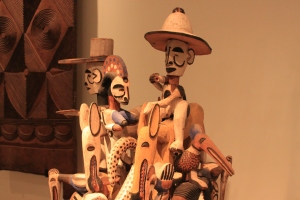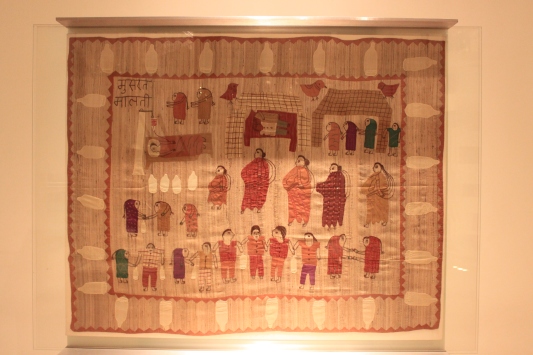
This is our lecturer Clare Rose and very often she takes us to different ongoing exhibitions. Talking about ‘Collecting thing,collecting people’, we guys headed off to the African hall at British Museum.
Literally, the idea about collecting thing and collecting people is about cultural exchange as a result of colonialism.
We were on the topic of discussing whether the spectators have neglected the development of Afican comtemporary art and design , while focus tracing back to their traditional craft idea.
____________________________________________________
The cultural exchange started back in 1600. The early contact among Europe, Africa and Asia was because of trades. However, often European was in a disadvantage as they have little to exchange. The hierarchical, courtyly society in Asia, Africa and Pacific seem ”normal” to European as those weren’t primitive.
However, after 1700 industialisation went on progress in Europe while non-industrial culture in Africa and Asia seemed old fashion to them. And when the religion war broke out in Europe (from 1600), it made religion a political issue. All the contact with Europeans changed the non-Europe culture. There were new diseases, new weapons, new forms of wealth. They gradually broke up with traditional societies and make them unstable.
The idea about ”collecting people” is after 1850 when Europeans started trading with other cultural places. ” The Pescent of Man ”(1871) by Charles Darwin has discussed on classifying plants, animals ….and people. It is about races, primitivism, ancestors… When European started those trades, they wanted to rule over the import places so as to guarantee stable supply for raw material( such as metal/ ivory/ cotton…). Therefore, there comes COLONIALISM.
If we looked at the colonial war at Benin…. so, Benin and Britain has traded since 1600. But this colonial war began when Britain invaded them due to quarrel over trade. The Benin Royal Palace was destroyed and part of it was brought back to British Museum. Those African artefacts were then displayed in Britain. The British liked it. The way of those African artefacts displayed emphasized ”exotic” and ”primitive”.

These are the Benin Bronzes —typical plaques portraying warriors
All those African culture introduced to Europe was vital. European bagan to take African Art as inspiration. For example, the Demoiselles d’ Avignon by Picasso in 1907.

The African culture encouraged a lot of modern art in Europe. European artists after Picasso admired African art as it was primitive. It flourished ! and so all these non-British culture are shown in the museum for us to explore!



This piece of Silk wall-hanging was made by a group of women from Adithi based in Patna, Bihar. The Adithi is an organisation that trains women handicrafts skills. They wanted to address issue such as poverty and social injustice and the spread of AIDS. This appliqued hanging depicts the different ways AIDS is transmitted: through blood transfusion, unprotected sex, from infected mother to her child. It also shows health worker distributing condoms as a mean of birth control education.





















